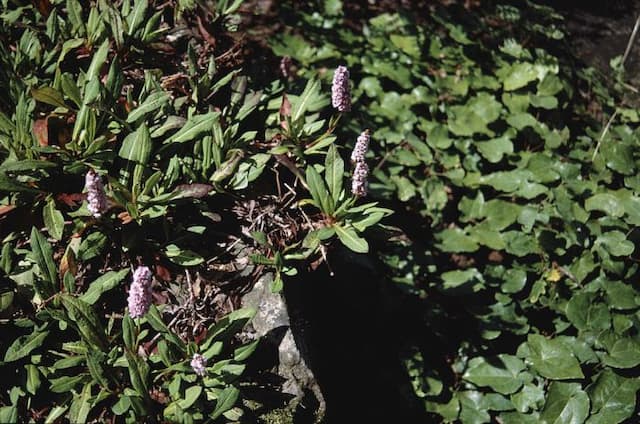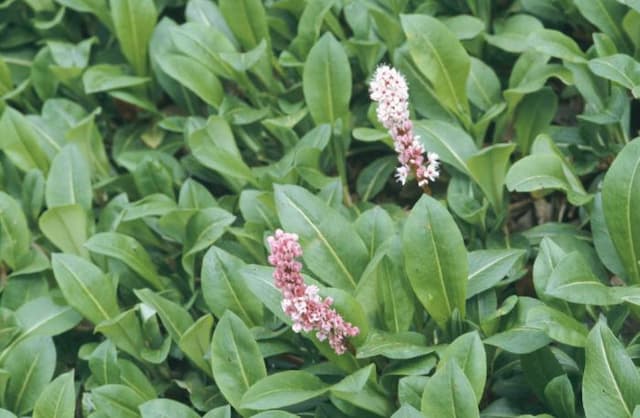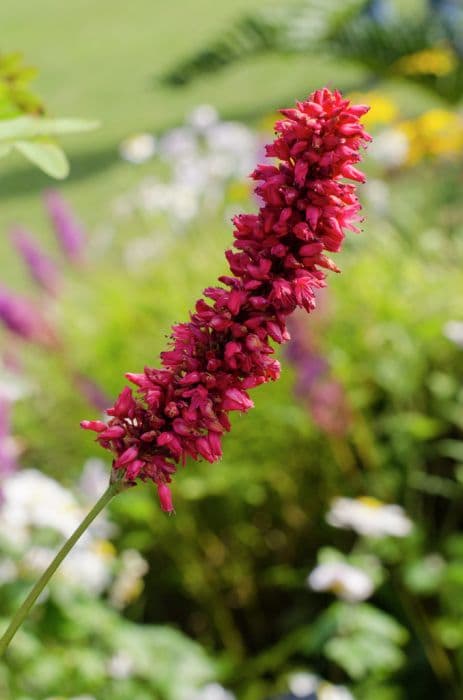White Flowered Mountain Fleece Persicaria amplexicaulis 'Alba'

ABOUT
Persicaria amplexicaulis 'Alba', commonly known as White Bistort or Mountain Fleece 'Alba', is an ornamental perennial plant known for its long blooming period and attractive features. It displays a bushy mound of large, pointed leaves that are typically a rich, dark green in color. The foliage forms a dense and lush cover, creating a backdrop for the striking flowers. The most remarkable aspect of the White Bistort 'Alba' is its slender, graceful spikes of small, delicate, bell-shaped flowers, which are pure white in color. These tiny flowers are densely packed along the upright flower stalks, which stand above the foliage, creating a soft, airy effect. The blossoms tend to have a slight drooping appearance, adding to their charm and giving the plant a relaxed, informal look. During its blooming season, the White Bistort 'Alba' becomes a focal point in the garden due to its continuous display of white flowers that persist for an extended period. The contrast between the dark foliage and the light flowers is particularly striking, making it a popular choice for mixed borders, cottage gardens, or as a feature plant in a perennial bed. Throughout the growing season, the White Bistort 'Alba' maintains a robust and full appearance, making it an excellent choice for gardeners who need a plant that provides lasting visual interest. It is also known for attracting pollinators, such as bees and butterflies, adding ecological value to the garden.
About this plant
 Names
NamesSynonyms
White Bistort, White Mountain Fleece, Red Bistort 'Alba'.
Common names
Persicaria amplexicaulis 'Alba'.
 Toxicity
ToxicityTo humans
The plant commonly known as Red bistort is not known to be toxic to humans. There are no documented cases of poisoning from ingesting parts of the Persicaria amplexicaulis 'Alba', and it is generally considered safe in this regard. Therefore, no symptoms of poisoning are expected from contact or ingestion of this plant.
To pets
Similarly to humans, the Red bistort is not commonly known to be toxic to pets. There is no significant evidence to suggest that ingestion of Persicaria amplexicaulis 'Alba' by pets would lead to poisoning or any adverse health effects. As with any non-food plant, ingestion in large quantities could potentially cause mild stomach upset, but this plant is not considered a common toxin for pets.
 Characteristics
CharacteristicsLife cycle
Perennials
Foliage type
Deciduous
Color of leaves
Green
Flower color
White
Height
3-4 feet (0.91-1.22 meters)
Spread
2-3 feet (0.61-0.91 meters)
Plant type
Herb
Hardiness zones
5
Native area
Himalayas
Benefits
 General Benefits
General Benefits- Attracts Pollinators: The Persicaria amplexicaulis 'Alba', commonly known as White Bistort or Red Bistort, is known for attracting bees and butterflies, which are vital for pollination in the garden.
- Long Flowering Period: It boasts a long flowering season, providing white spires of flowers from early summer to autumn, which keeps gardens visually appealing for an extended time.
- Low Maintenance: The plant is relatively easy to care for, requiring only minimal maintenance once established, making it a good choice for gardeners at all levels of experience.
- Drought Resistance: Once established, it has good drought tolerance, reducing the need for frequent watering during dry periods.
- Rapid Growth: It grows quickly, which can be beneficial for filling in garden spaces and creating a lush landscape in a short amount of time.
- Erosion Control: Its dense foliage and mat-forming habit can help prevent soil erosion in garden settings.
- Deer Resistant: This plant is generally resistant to deer, which is particularly important in areas where deer browsing can be a problem for gardeners.
- Tolerant of Various Soil Types: While it prefers moist, fertile soil, it is tolerant of a range of soil types, which can be helpful in different garden settings.
- Architectural Interest: White Bistort adds structural complexity to plantings with its tall, slender flowering spires and large, heart-shaped leaves.
- Used for Borders and Ground Cover: Its size and habit make it suitable for use in borders, waterside plantings, and as a ground cover in open areas.
- Provides Contrast in Plantings: The pure white flowers provide a striking contrast against green foliage and can be used effectively to break up more densely colored plantings in garden design.
 Medical Properties
Medical PropertiesThis plant is not used for medical purposes.
 Air-purifying Qualities
Air-purifying QualitiesThis plant is not specifically known for air purifying qualities.
 Other Uses
Other Uses- Dye Production: The leaves and stems of the Mountain Fleece can be used to create natural dyes for textiles, giving subtle hues that are environmentally friendly.
- Photography: With their delicate white spikes, Mountain Fleece flowers offer a serene subject for botanical photographers and nature enthusiasts.
- Culinary Decoration: While not widely known for its edibility, the blooms can be used as a garnish for salads and desserts for decorative purposes.
- Artistic Inspiration: Artists may use the Mountain Fleece as a subject or inspiration for botanical drawings, watercolor paintings, and other art forms.
- Education: These plants can be used in educational settings to teach about pollination, as they are highly attractive to pollinators like bees and butterflies.
- Companion Planting: The Mountain Fleece works well as a companion plant, providing structural support for neighboring plants and creating contrasting foliage in gardens.
- Erosion Control: Due to its expansive root system, Mountain Fleece can help stabilize soil in areas susceptible to erosion.
- Habitat Creation: The plant can be used in wildlife gardens to create habitats for beneficial insects and small animals, contributing to biodiversity.
- Floral Arrangements: Fresh or dried, the spires of Mountain Fleece can be a unique addition to floral arrangements, providing height and texture.
- Seasonal Celebrations: The white blossoms of Mountain Fleece can be used to symbolize purity and new beginnings during seasonal celebrations such as weddings or spring festivities.
Interesting Facts
 Feng Shui
Feng ShuiThe Bistort is not used in Feng Shui practice.
 Zodiac Sign Compitability
Zodiac Sign CompitabilityThe Bistort is not used in astrology practice.
 Plant Symbolism
Plant Symbolism- Endurance: Persicaria amplexicaulis 'Alba', commonly known as White Bistort, features robust and persistent growth which symbolizes resilience and the ability to withstand challenges.
- Unity: The way White Bistort flowers are clustered on spikes represents coming together and unity, making it a symbol of togetherness and community.
- Prosperity: With its lush foliage and abundant blossoms, White Bistort is often associated with abundance and prosperity.
- Healing: Traditionally, members of the Persicaria genus have been used in medicinal remedies, so it also symbolizes healing and the soothing of ailments.
 Water
WaterRed Bistort 'Alba' thrives best with consistent moisture, so it is important to water it regularly. During the growing season, ensure the soil remains evenly moist but not waterlogged. This could mean watering the plant approximately once a week with about 1.5 gallons of water, depending on the climate and weather conditions. However, make sure to reduce watering in the winter when the plant is dormant. In hot summer periods or particularly dry conditions, frequency of watering might need to increase, monitoring the soil moisture as a guide.
 Light
LightRed Bistort 'Alba' performs well in full sun to partial shade. The ideal spot would allow for morning sunlight and protection from the intense heat of the afternoon sun, particularly in hotter climates. Bright indirect light will help ensure an abundance of flowers throughout its blooming season.
 Temperature
TemperatureRed Bistort 'Alba' is hardy and can tolerate a wide range of temperatures. Ideally, it thrives in temperatures between 50°F and 70°F. It can survive minimum temperatures down to around -20°F and can tolerate summer heat as long as it is not prolonged and the plant is well-watered.
 Pruning
PruningRed Bistort 'Alba' benefits from pruning to encourage bushier growth and more blooms. Cut back the faded flower stems and any dead or damaged foliage to keep the plant looking tidy. Pruning can be done in late autumn or early spring before new growth starts, generally once a year for maintenance.
 Cleaning
CleaningAs needed
 Soil
SoilThe Red Bistort 'Alba' prefers a soil mix that retains moisture but is also well-draining, with rich organic matter. A mix of garden soil, compost, and some perlite or coarse sand to improve drainage works well. The ideal soil pH for Red Bistort 'Alba' is between 6.0 and 7.0.
 Repotting
RepottingRed Bistort 'Alba' typically does not need frequent repotting as it is a perennial plant. It can be left undisturbed for several years and only repotted or divided when it outgrows its space or when the center of the clump starts to die out.
 Humidity & Misting
Humidity & MistingRed Bistort 'Alba' is tolerant of a wide range of humidity levels, but it prefers normal to high humidity conditions. It will thrive outdoors in an environment with natural humidity without the need for special attention to humidity levels.
 Suitable locations
Suitable locationsIndoor
Ensure bright, indirect light and maintain moist soil for Red Bistort 'Alba'.
Outdoor
Plant in partial shade, keep soil moist, and protect from harsh sun for Red Bistort 'Alba'.
Hardiness zone
4-9 USDA
 Life cycle
Life cyclePersicaria amplexicaulis 'Alba', commonly known as White Bistort or White Fleece Flower, begins its life cycle as a seed, which, when sown in fertile, moist soil, will germinate usually in the spring. The seedling emerges and develops into a young plant with characteristically broad leaves, gradually maturing over the course of several weeks. As the plant reaches maturity, usually in its second or third year, it produces tall, slender spikes with small white flowers blooming from early summer to mid-autumn. After pollination, often by insects, the flowers give way to small fruits (achenes) that contain the seeds for the next generation. In winter, White Bistort dies back to the ground, surviving as a perennial root system that resprouts in the following spring to complete the cycle. Over years, it can form large clumps through vegetative reproduction, expanding its presence in a garden or naturalized area.
 Propogation
PropogationPropogation time
Summer to Fall
The most popular method for propagating Persicaria amplexicaulis 'Alba', commonly known as White Bistort or Mountain Fleece, is by division. This process is generally done in the spring as the plants begin to grow or in the early fall, after the blooming period has concluded. To propagate by division, gently dig up the plant and carefully separate the root clump into smaller sections using a sharp knife or spade, ensuring that each division has a section of the root system and several shoots. These divisions can then be immediately replanted in the ground at the same depth they were originally growing, spaced about 12 to 24 inches apart (approximately 30 to 60 cm). The soil around the new divisions should be firmed down and watered thoroughly to help establish them. This method is simple and effective, promoting healthy growth and increasing the number of White Bistort plants in your garden.






![Red bistort [Taurus]](/_next/image?url=https%3A%2F%2Fplants-admin.emdemapps.com%2Fimages%2Fplants%2F%2Fimages%2F604b548be7841.png&w=640&q=75)


